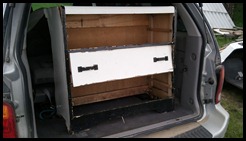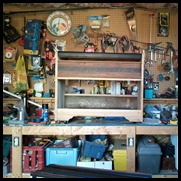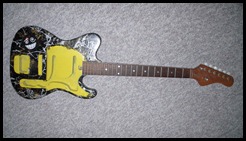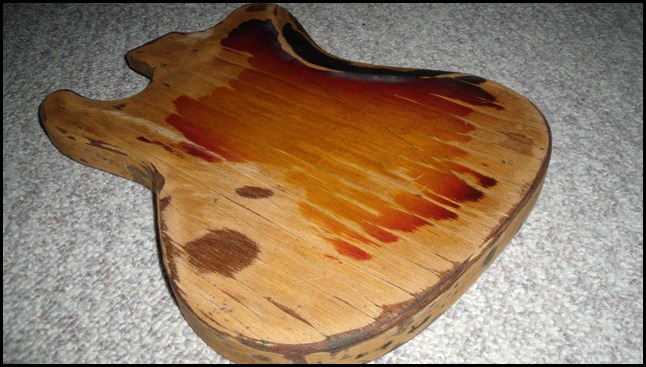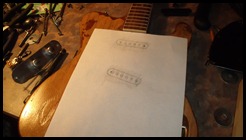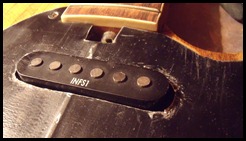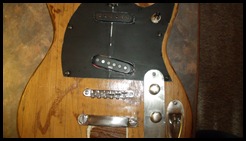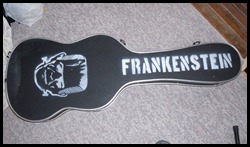About Kyle Chamberlain
I am a new media developer and multimedia professional graduate from Assiniboine Community College in Brandon, MB.
My studies focused on audio and video production for broadcast television, audio engineering, as well as multimedia production for the web.
Interests of mine are wide and range from e-learning, music production, physical science, business solutions, technology systems and social media.
I also have an interest in making use of my strong communication skills in order to develop and manage a fresh and challenging work environment.
Never without an acoustic guitar out-of-reach, I continue to work on original music with more than a half-dozen songs already recorded for an album I plan on calling Seattle On Fire.
With no time restrictions on the recording of this album, I'm taking part in many other musical projects in various roles ranging from producer/engineer, guitarist, vocalist and more.
Thinking for a long time that I wanted to build a custom cabinet for my Vox AC30 CC2; I finally found the final piece of the puzzle: An old bedroom dresser.
Wait, what?
More To come, seriously.
Tags: ac30, amp, amplifier, Brandon, cabinet, Canada, Custom, diy, dresser, from the shed, guitar, home made, kyle chamberlain, Manitoba
In this debut episode of From The Shed, Kyle Chamberlain modifies two nightstands in order to build a custom guitar amp cabinet called a JamStack.
Tags: amp, build, cabinet, conversion, Custom, from the shed, guitar, jamstack, kyle chamberlain, modified, tutorial
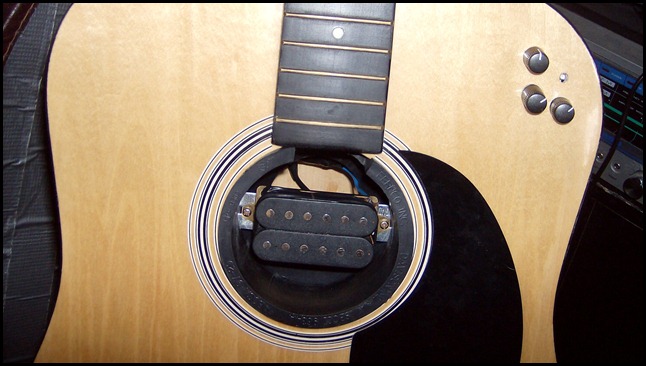
I like the blues. Sometimes I like the grubbiest, dirtiest, acoustic blues around.
When I first moved to Winnipeg in 2007 I had left all my gear back in Brandon. After one weekend of no music I knew I had to get my hands on a cheap guitar. In a pawn-shop music store downtown I found this sad looking acoustic guitar for $20.00. How could I go wrong?
The guitar served it’s purpose and gave me the opportunity to write licks while staying with family. Once I did move into my own place the guitar became a decoration; first above my bar and then in a window. I began thinking of ways to have a fine-tuned dirty acoustic sound, but not have a need for a specific amp or any pedals.
I decided that giving this old acoustic a Humbucker and a distortion pedal was the way to do it.
Another project of mine left me with a bridge pick-up from a Les Paul copy, and after much trial and error I found two items in my scrap box to use: The brace from an electrical light box and a rubber gasket for a toilet seal. Mounting the Humbucker in the sound hole, now it was on to the built in distortion pedal.


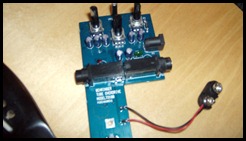


Complete with a 9v battery compartment to power the Behringer Tube Overdrive board installed beneath the surface, this guitar is still a good acoustic. But where it really shines is in the control it offers for shaping your sound. Now with three knobs; Drive, Tone, and Level, this is the perfect dirty acoustic blues guitar around. The gasket works great to reduce feedback, yet allows the guitar to still resonates with the vibration of the strings. Being able to increase the gain yourself, it works fine to play clean acoustic, allowing for shaping with a single tone control.
Tags: Acoustic, Another, Behringer, blues, Brandon, compartment, Complete, decoration, distortion, downtown, Drive, error, feedback, gasket, gear, guitar, Humbucker, items, knobs, Level, music, Once, Overdrive, Paul, purpose, Rubber, Scream, Sometimes, toilet, tube, vibration, Wilhelm, winnipeg
I got my hands on this Telecaster copy from the early 90’s. It was a gift from a fan who hoped, “It would got to a good home where someone might play it once in a while.”.
There was no doubt that this guitar had seen a few owners and that it had been a starter model once upon a time. With a fairly straight neck and no initial investment I decided that this guitar would become a personal project.
I began by removing all the hardware and electronics, sanding down through seven layers of hell, and shopping for higher quality replacement parts.
Finding the original sunburst on the back, I left some of the finish for cosmetic and sentimental purposes. I used deck stain (left over from a home renovation project), Hanging the body off a guitar stand with a coat hanger hooked through a hole for the neck bolts.
I used a block of wood and some wood filler to close-up the hole in the front face where the tremolo had been. Using the original pick-guard and jack/control plate as templates, I cut out aluminum from old ductwork to use as the replacements. Painting the pick-guard black and sanding it for color and texture was more challenging than I can describe. There are more than a dozen coats of paint, which ends up adding character as well as contrast compared to the jack/control plate that I left simple as sanded aluminum.
|
Before
|
After
|
 |
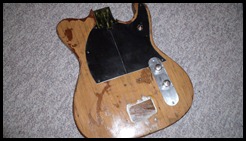 |
Here was my eBay shopping list:
- Stock Stratocaster Boat-Jack
- Two heavy chrome knobs
- Gibson Les Paul style bridge-saddles & hard tailpiece
- Grover mini-locking tuners
- Wilkinson Vintage single coil bridge pickup
- Oversized strap buttons & screws
- Fender tweed guitar strap
- Frankenstein pin
- Frankenstein coin
While waiting on everything to come in the mail I stopped in at the local hardware store and picked up a five inch bolt since the guitar was originally a zero-nut style of headstock.
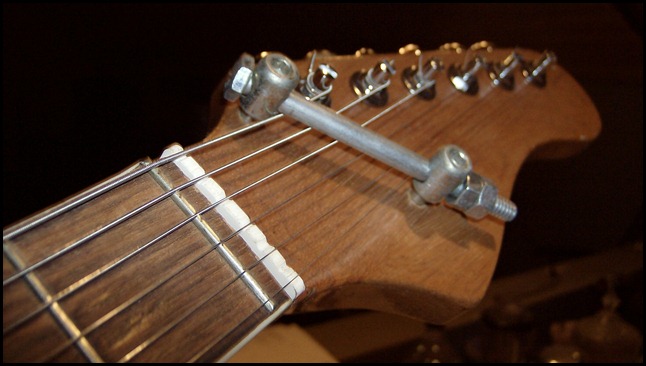
When the hardware arrived from eBay I was ready. I had already drawn up the schematics and wiring diagrams, so that was my first chore. I began by retrofitting the boat-jack onto the face of the guitar and sanding the heck out of the knobs. To make things even more challenging, I decided I wanted the boat-jack to be slightly recessed.
Once that was done, it was time to cut & place the pickups. I decided on One Volume / One Tone too keep it simple; the Wilkinson Vintage up front and a stock Ibanez INFS1 middle pickup (from a friend) in the bridge position. A three-way switch wired neck / both / bridge and the boat-jack complete the circuit.
Once the bridge and tailpiece were added it began to look like a guitar again. For adventures sake, I scalloped the last few frets and made the neck plate recessed.
With the Grover’s already installed, there were only a few cosmetic additions to the guitar and it’s case before it was complete.
Review
Now dubbed Frankenstein, this guitar performs great considering. I keep it in open G tuning and use it a lot for slide work. Keeping the intonation set correctly is a constant battle. Generally I give it a good work out and simply compensate as best I can – much easier when playing slide.
The tones I get from Frank are pretty basic: weak & twangy or strong & dirty. What this guitar lacks in versatility it makes up for with character and clarity. Even through the thickest fuzz or distortion, the Wilkinson Vintage provides a crisp attack, which again works great for slide.
Tags: additions, adventures, aluminum, Boat, circuit, Custom, diagrams, distortion, eBay, electronics, Fender, filler, Frank, Frankenstein, friend, fuzz, Gibson, gift, Grover, guitar, hanger, hardware, hell, Here, Ibanez, intonation, investment, jack, knobs, layers, neck, Once, owners, Paul, purposes, renovation, replacements, Review, schematics, starter, Stock, Stratocaster, tailpiece, Telecaster, templates, texture, Vintage, Volume, Wilkinson, wood, zero
After playing solid state amps all my life, I knew that it was time to venture into “tube world”. I like the sound of vintage stacks and small boutique combos, so I knew that this purchase was going to be one of the classic tube amp variety.
With my eyes open for weeks, I had found a few Vox AC30 reissues that I liked, but none of them in my price range. Then viola, an ad on kijiji.com! I picked up the CC2X version of the Vox AC30, a Gator case and the Vox effects control pedal (normally sold separately) for less than stores were selling just the amp for.
Needless to say, I’m very impressed with this combo amp. With very few controls the Vox still offers a plethora of options for shaping and controlling your tone. Whether it’s a classic rock crunch, a country twang, or a dirty blues; this amp pushes the sound with specs that suggest a 40 Watt output through a total of eight tubes (4 x EL84, 3 x 12AX7, 1 x GZ34).
So far my only complaint about the amp is the weight. Coming in just under 80 lbs., the amp comes stock with thick plastic handles that make carrying this amplifier up stairs or long distances a painful chore. The Gator case that was a part of my purchase protects the amp well during travel and transport, but makes moving the amp a two person job due to it’s size and awkwardness.
Again, the tones this amp is able to produce are fantastic. Although I use a pedal board (brownie points for the Effects Loop), I have no problem performing on stage with this amp sans tone boxes.
Tags: 30, ac, ac30, Again, Although, amplifier, amps, blues, brownie, Classic, complaint, Custom, Effects, Gator, life, Loop, Options, output, person, plethora, size, specs, stairs, tube, tubes, version, Vox, Watt, Whether

- Produced in The Saein Musical Instrument Complex in Incheon, Korea in 2003.
- 3 Alnico-V mini-humbuckers
- Gold hardware
- Maestro Lyre Vibrola tailpiece
- Mahogany body
- Mahogany set neck construction
- 3 Vol/1 Tone with 3-way selector switch
- Gold reflector knobs
- 22-fret Rosewood fingerboard with block inlays
- 24.75″ scale
- 1.68″ nut width
- $831 MSRP (2005)
- Color Options: Black, Antique Ivory, Red, and Vintage Sunburst (2002-2005).
I found this guitar for sale online in 2010. Prior to finding the ad, I had been watching for a good deal on a new toy for some time. I had even done some research on a few models that I saw frequently in pawn shops and Winnipeg’s music stores.
Looking for an upgrade from my regular standard of guitars, I also hoped to find something that suited my blues/rock style of playing and had a unique look to it – as imagery is very important to me when on stage.
A Little Firebird History:
The president of Gibson in the 1960s, Ted McCarty, hired car designer Ray Dietrich to design a guitar that would have popular appeal. Under Dietrich, the Firebird took on the lines of mid-50s car tailfins. Dietrich took the Explorer design (which had commercially failed a few years earlier) and rounded the edges. The most unusual aspect is that the guitar is “backward” in that the right-hand (treble) horn of the body is longer than the other. Thus, the original Firebirds were unofficially referred to as “reverse”.
The Firebird line went on sale in mid-1963 with four models distinguished by pickup and tailpiece configurations. Unlike the Les Paul and SG line, which used the terms “Junior”, “Special”, “Standard” and “Custom”, the Firebird used the Roman numerals “I”, “III” , “V” and “VII”. Gibson’s line of Thunderbird basses is rooted in the design of the Firebird, and uses even Roman numerals (“II” and “IV”) to distinguish it.
Epiphone, being a subsidiary company of Gibson, was given authorization to produce this reissue from 2000-2005.
Being that it was listed as “used” condition, I was weary, but there was no evidence of abuse from the pictures posted in the ad. After recently receiving an income tax rebate, I decided that this was something I’d have to take a serious look at. Not finding much information on the Epiphone Firebird line right away, I went to inspect the guitar in person.
The moment I walked into the room my eyes darted towards the bright red Firebird VII sitting neatly along a wall of guitars. Right away I knew that this guitar was going to do what I wanted it to do. I low-balled the seller by another hundred dollars and he met me halfway. I felt that I was practically stealing this guitar as the guy apologized for the lack of a hard-shell case.
Review
I find the Epiphone Firebird VII to be an amazing guitar. No other instrument in it’s class performs better or guarantees the quality that my guitar has delivered.
Finding that the three Alnico-V Mini-Humbuckers outperform most stock-quality Epiphone pickups was a pleasant surprise. With the configuration of 2 Volume / 1 Tone and a Blend potentiometer for the middle pickup, there are virtually millions of tones achievable through the three-way toggle switch.
The Maestro Lyre Vibrola tailpiece and tremolo bar are a bit tricky to setup, but with a knowledgeable technician or luthier helping you with your regular set-ups you’ll find that the traditional mechanical design works flawlessly.
With matching gold Grover Tuners coming stock on this beautiful redhead, I can’t help but to love her. Holding it’s position as my “go to” electric guitar, I can’t imagine my collection being complete without this Firebird VII.
Tags: Alnico, Antique, aspect, authorization, Black, Blend, blues, collection, Color, Complex, configuration, configurations, construction, Custom, Dietrich, dollars, Explorer, Firebird, Firebirds, Gibson, Gold, Grover, guitar, guitars, History, horn, Humbuckers, imagery, Incheon, income, information, Instrument, Ivory, Junior, knobs, Korea, Little, Lyre, Maestro, Mahogany, millions, Mini, moment, MSRP, music, Musical, neck, numerals, Options, Paul, person, president, Prior, rebate, reflector, Reissue, Review, Roman, room, Rosewood, Saein, sale, selector, seller, setup, Special, Standard, Sunburst, tailpiece, technician, three, Thunderbird, Thus, Tuners, Under, Vibrola, Vintage, Volume, width, winnipeg


